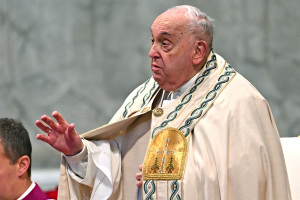Who was St. Andrew and why is he the patron saint of Scotland?

Nov. 30 is St Andrew's Day. Who was St. Andrew and why is he patron saint of Scotland?
Patron saints
In the Catholic and Orthodox traditions, a patron saint is a canonized historic holy person who is supposed to be a guiding and protective force for people of a particular profession or region. After the Reformation the idea of patron saints was dropped by Protestants. However, the idea of national patron saints remains in Britain and Ireland, but more for patriotic and historical rather than religious reasons. St. David is patron saint of Wales, St. Patrick of Ireland, St. George of England and St. Andrew of Scotland.
The Apostle Andrew
St. Andrew is mentioned in all four Gospel accounts and in Acts. Andrew was first a disciple of John the Baptist (John 1:40), and when he recognized Jesus as the Messiah he was quick to find his brother Simon (later called Peter) to tell him (John 1:41).
Andrew and Peter were fishermen at the Sea of Galilee (Matthew 4:18, Mark 1:16), and were the sons of John (John 1:42), and originally came from Bethsaida (John 1:44)). It is not known for sure whether Andrew was the older brother or the younger brother, but generally people have traditionally thought of Andrew as the older brother.
At the time of the Gospels, Andrew and Peter were living in Capernaum where Andrew was living with his brother, Peter, and Peter's wife and mother-in-law (Matthew 8:13, Mark 1:29). Possibly Andrew was married, too, but there is no direct mention of his wife. It seems that Jesus often stayed with them there. Andrew and Peter were among the disciples who became apostles (Matthew 10:2, Mark 1:18, Luke 6:14).
Andrew is specifically named in three stories. After Jesus foretold the destruction of the Temple (Mark 13:1-2), it was Andrew, Peter and John who asked Jesus about the signs of the End Times (Mark 13:3).
In the well known story of Jesus feeding the 5,000 it was Andrew who introduced Jesus to the boy with the five barley loaves and two fish (John 6:8). After Jesus entered Jerusalem (which is recalled on Palm Sunday), some Greeks were worshiping with the Jews at Jerusalem and they approached Philip and asked to see Jesus. Philip went and told Andrew who then told Jesus. (John 12:20-22). Andrew is at the Last Supper and at Pentecost (Acts 1:13) and then disappears from the narrative. In such cases the gap is filled in by Early Church history and tradition.
Black Sea missions
St Andrew is supposed to have been shipwrecked on Cyprus, maybe on the way to Byzantium (later Constantinople and now Istanbul) where he is reputed to have founded the bishopric which later became the Patriarchate of Constantinople.
According to the Early Church historians Origen (c185-c253) and Eusebius (c260–265), Andrew went to take the Gospel to Scythia, which was the area to the north of the Black Sea, which today includes the coastlines of Romania, the Ukraine, parts of Russia and Georgia. As a result, the Orthodox Churches in Romania, Russia, Ukraine and Georgia have St. Andrew as their Apostolic founder.
Death
The generally accepted tradition is that Andrew was martyred by crucifixion at Patras in Achaea (now in Greece) in AD 60. He thought that he was not worthy to be martyred on the same type of cross as Jesus had been, and so he was crucified on an x-shaped cross instead. Many of St Andrew's relics are reputedly kept in St. Andrew's Orthodox Cathedral in Patras, which is a place of pilgrimage.
Patron saint
Because Andrew is seen as the apostolic founder of their churches, St. Andrew is patron saint of Cyprus, Georgia, Greece, Romania, Russia and Ukraine. He is supposed to be the patron saint of fishermen and fishmongers. How he came to be patron saint of Scotland is more curious.
Connection to Scotland
Some of St Andrew's relics were reputedly brought to Scotland by St Regulus, a fourth century monk, who in AD 345 is supposed to have fled Patras for Scotland taking with him many of St. Andrew's bones. The story goes that St. Regulus had a dream in which Patras was under threat of attack, and he had to take the relics as far away as possible to the Western ends of the Earth.
Sailing in the North Sea, St. Regulus and his party were shipwrecked off the coast of Fife, where he was welcomed by the local Pictish king. A church and monastery dedicated to St. Andrew arose at the site, and St. Andrew became an important saint for the Picts. The town was named after him, and now St. Andrews is famous for its ancient university and as the home of golf.
St Andrew's flag
St. Andrew's cross is based on the diagonal shape of the cross that St. Andrew was put to death on. In heraldry a saltire is a diagonal x-shaped cross. There are two forms of the saltire. In one form, there is a blue cross on a white background, and in another form there is a white cross on a blue background. The Russian Navy uses a St. Andrew's flag which is a blue saltire on a white background, because St. Andrew is patron saint of Russia.
Scottish flag
The form of St. Andrew's cross with a white cross on a blue background is said to date back to a great battle between the Picts in AD 832. An army of Picts under King Hungus, High King of Alba, were being pursued by a larger force of Angles and Saxons from Northumbria, under their King Athelstan. Fearing the outcome of the encounter, King Angus prayed for victory to St. Andrew, and he saw a cloud formation that looked like a white saltire against a blue sky. This looked like St. Andrew's cross, and so he took this as a sign. The Scots won the battle, and where King Athelstan was killed is now the village of Athelstaneford in East Lothian.
Later when Kenneth MacAlpin united the Picts and Scots into the Kingdom of Scotland, St. Andrew became the patron saint. Later the white cross on the blue background was adopted as the national flag of Scotland, and is one of the oldest national flags in the world, although not always with the same shade of blue.
St Andrew's cross in the Union Jack
In 1606, after the crowns of England and Scotland were united, the jack of St George's cross used in England, and the jack of St Andrew's cross used in Scotland were combined to create the Union Jack (the jack referring to a small flag flown on a ship). In 1801, after the union with Ireland, the jack with St. Patrick's cross was added to create the current version of the Union Jack. Thus the flag of the U.K. has the St. Andrew's cross in the background, and this also appears in the canton (top left hand quarter) of the flags of Australia and New Zealand.
Today St. Andrew's flag is flown widely in Scotland, but is best known internationally from sporting events, where Scotland plays separately from the other nations of the U.K., notably in football, rugby and in the Commonwealth Games. It is also the basis of the flag of Nova Scotia (Latin for New Scotland) in Canada.
St Andrew's Day
St Andrew's Day is observed on Nov. 30 in the Anglican, Catholic and Orthodox churches, and since 2007 has been a bank holiday in Scotland. In Scotland and Scottish communities round the day is an excuse for patriotic celebrations.
Let us remember that St Andrew, unique of all the national patron saints of the U.K., is the only one who was an actual biblical figure.
The article was originally published at Christian Today





























